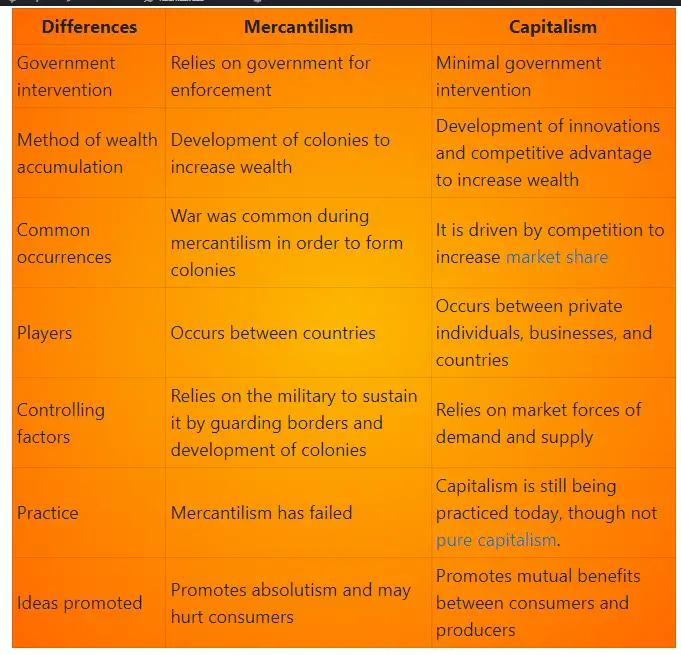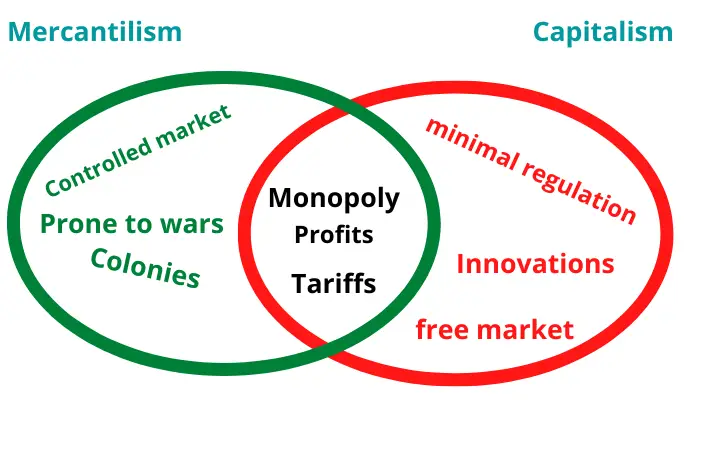What are the differences between mercantilism vs capitalism?
Mercantilism and capitalism are two economic systems practiced by nations throughout history. Though they share some similarities, there are also several essential ways in which they differ. So, what’s the difference between capitalism and mercantilism? Mercantilism was an early form of capitalism that emerged in the 16th and 17th centuries. Unlike modern capitalism, mercantilism was focused on accumulating wealth and power for governments, rather than individuals or businesses. Mercantilist policies often included things like trade barriers and restrictions on colonies, in order to keep money and resources flowing into the home country.
Rise of mercantilism and capitalism
The mercantile theory arose during the early modern period when nations were competing for resources and markets. It was a response to the feudal system, which placed limits on trade and commerce. Mercantilism held that the key to economic success was to increase one’s own exports while restricting imports from other nations. The goal was to amass more wealth, which would in turn lead to more political power. The theory was influential in shaping government policy during the 16th-19th centuries. It began to decline in importance with the rise of laissez-faire economics in the late 18th century, and it was largely discredited by the mid-19th century.
The earliest form of capitalism can be traced back to the medieval era when merchants and traders began to accumulate wealth through trade. The rise of capitalism as an economic system took place during the Industrial Revolution in the 18th and 19th centuries when new technologies and production methods made it possible to produce goods on a large scale. During the 20th century, capitalism spread throughout the world, becoming the dominant economic system in most countries. However, it has also come under criticism from those who argue that it leads to inequality and exploitation.
What is mercantilism?
Mercantilism is an economic theory that holds that the wealth of a nation is increased through the accumulation of gold and silver. The theory also holds that trade surplus is the key to wealth and that colonies should be established to provide raw materials and markets for finished goods.
In the mercantilist system, the government intervenes heavily in the economy in order to promote economic growth. This intervention takes many forms, including tariffs, subsidies, and regulations. The goal of mercantilism is to increase the amount of wealth and power that a nation has relative to other nations.
What is capitalism?
Capitalism is an economic system in which private individuals or businesses own the means of production and distribution. This means that instead of the government owning and regulating industries, businesses are free to operate however they see fit, within the bounds of the law. This can lead to a lot of different outcomes, both good and bad.
In capitalism, the economy is mostly free from government intervention. This allows businesses to compete freely in the marketplace, and it gives individuals the freedom to pursue their own economic goals. The goal of capitalism is to create wealth and efficiency through competition and innovation.
On the plus side, capitalism encourages competition and innovation as businesses try to outdo each other to attract customers and make more money. This can lead to better products and services for consumers, as well as new jobs and economic growth. On the downside, capitalism can also lead to income inequality and exploitation, as businesses strive to maximize profits at all costs.
Some key differences between mercantilism and capitalism
- Mercantilism is an economic theory that holds that the wealth of a nation is best increased through a favorable balance of trade. In other words, a country should export more than it imports, and it should avoid importing goods that can be produced domestically. Whereas, capitalism is an economic system in which private individuals or businesses own the means of production and operate for profit. The government plays a limited role in the economy under capitalism.
- Mercantilism relies heavily on government intervention in the economy, while capitalism relies on the free market.
- Mercantilist policies are often protectionist, while capitalist policies are typically free trade.
- The mercantilist theory believes wealth is fixed and finite; hence the country with the most gold and other precious metals would have more economic power and wealth. Capitalism believes wealth can be increased by productivity and innovation, hence it is not fixed.
- Under the capitalist system, an individual can buy whatever he or she wants, whether it is luxury or a need; but in the mercantile system, there was a restriction on luxury items and the government preferred people to amass wealth for their nation instead of luxury to themselves.

There are other key differences between mercantilism and capitalism, which can be summarized in the table below:
Main differences between mercantilism vs capitalism
| Differences | Mercantilism | Capitalism |
|---|---|---|
| Government intervention | Relies on government for enforcement | Minimal government intervention |
| Method of wealth accumulation | Development of colonies to increase wealth | Development of innovations and competitive advantage to increase wealth |
| Common occurrences | War was common during mercantilism in order to form colonies | It is driven by competition to increase market share |
| Players | Occurs between countries | Occurs between private individuals, businesses, and countries |
| Controlling factors | Relies on the military to sustain it by guarding borders and developing colonies | Relies on market forces of demand and supply |
| Practice | Mercantilism has failed | Capitalism is still being practiced today, though not pure capitalism. |
| Ideas promoted | Promotes absolutism and may hurt consumers | Promotes mutual benefits between consumers and producers |
| Market | Controlled | Open market |
| Tariffs | Very high | Low |
| Trade favorability | Favors exports | Favors free trade |
Key similarities between mercantilism vs capitalism
- There are a few key similarities between mercantilism and capitalism. Both systems emphasize the importance of private property and the accumulation of wealth.
- Both systems also encourage trade and the pursuit of profit.
- Mercantilism and capitalism can both lead to monopoly. A mercantilist country may want to accumulate wealth such as gold and silver so that other countries depend on it whereas the monopoly in capitalism may lead to wealth accumulation to an individual, business, or even a certain country having an absolute advantage.
- Both have tariffs in trade; even though that of the mercantile system is very high while the capitalist system is low.
So, while there are some similarities between mercantilism and capitalism, there are also some important differences.
What is the difference between mercantilism and capitalism?
Mercantilism is driven by a controlled market that leans towards colonies and it is prone to war whereas capitalism is driven by innovations with minimal control (a free market). The Venn diagram below gives the graphical differences between mercantilism and capitalism.
Mercantilism vs capitalism venn diagram

FAQs
What is the main difference between mercantilism and capitalism?
Mercantilism and capitalism differ mainly in the method of economic control; while mercantilism relies on the government to control the economy through regulations and military enforcement, capitalism relies on the free market forces.
Is mercantilism better than capitalism?
Capitalism is better than mercantilism because it encourages competition and innovation. This allows businesses to flourish by competing with each other which then drives innovation and lower prices for consumers.
How is mercantilism similar to capitalism?
One key similarity between capitalism and mercantilism is that the two systems encourage trade and the accumulation of wealth.
Conclusion
There are several key differences between mercantilism and capitalism. Mercantilism is an economic system in which the government intervenes heavily in the economy to promote exports and discourage imports; while capitalism is an economic system in which businesses operate independently of government intervention. Additionally, mercantilist economies tend to be more focused on accumulating wealth, while capitalist economies are more focused on innovation and growth. However, both systems share some similarities, such as the importance of private property rights and the role of competition in driving economic activity.
Nansel is a serial entrepreneur and financial expert with 7+ years as a business analyst. He has a liking for marketing which he regards as an important part of business success.
He lives in Plateau State, Nigeria with his wife, Joyce, and daughter, Anael.
